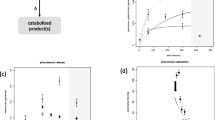Abstract
Several mechanisms have been proposed to underlie the characteristic `zigzag' tracks produced by moths flying up an odor plume. To test which, if any, of these are capable of reproducing the animals' behavior, we constructed behavioral-level simulations. The simulations are as tightly constrained as possible by the known biology, and incorporate realistic physical effects such as air turbulence, and delays due to sensory transduction and axonal condition, to mimic the dynamics of sensory information encountered by real moths. Formulated as schemas, the models all share a common set of sensory and motor systems, but differ in the interposed control systems. We analyzed the behavior of the models with the same methods we use for real moths. Even the simplest of the models was capable of successful orientation some of the time, and of producing flight tracks similar to those of moths. Individuals which succeeded in tracking the odor plume produced average behavior not significantly different from that of real moths. As a population, however, none of the models was as successful as the moths. The best of the models had a success rate in tracking the plume of about 30%, compared to the average of 70% seen in the insects.
Similar content being viewed by others
Author information
Authors and Affiliations
Additional information
Accepted: 25 March 1998
Rights and permissions
About this article
Cite this article
Belanger, J., Arbas, E. Behavioral strategies underlying pheromone-modulated flight in moths: lessons from simulation studies. J Comp Physiol A 183, 345–360 (1998). https://doi.org/10.1007/s003590050261
Issue Date:
DOI: https://doi.org/10.1007/s003590050261




